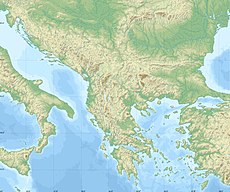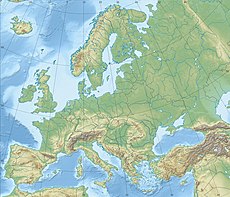Deliblato Sands (Serbian: Делиблатска пешчара, romanized: Deliblatska peščara; Hungarian: Delibláti-homokpuszta) is a large sand area covering around 300 km2 (120 sq mi) of ground in Vojvodina province, Serbia. It is located in southern Banat, situated between the river Danube and the southwestern slopes of the Carpathian Mountains. The sands are named after the village of Deliblato,[1] in the municipality of Kovin. Its main masses are elliptical shaped hills with steppe grassland plains and steppe forests.
| Deliblato Sands | |
|---|---|
| Делиблатска пешчара Deliblatska peščara | |
 Deliblato Sands | |
| Floor elevation | 250 m (820 ft) |
| Area | 300 km2 (120 sq mi) |
| Geography | |
| Location | Banat, Vojvodina, |
| Coordinates | 44°53′01″N 21°05′33″E / 44.88361°N 21.09250°E |
The Deliblato Sands is the largest sandy terrain in Europe, once part of a vast prehistoric desert, having originated from the withdrawal of the Pannonian Sea. They are home to many endemic species of plants and animals which are rare or endangered in Europe and globally. Due to its forest and surroundings, it was declared a special nature reserve. On a national level, it represents a natural asset of special importance falling under protection category I.
It is referred to as the "European Sahara", or the "Old Continent's oldest desert".[1]
Geography
editThe Deliblato is an expanse of Aeolian processes with significant dune-like relief made of powerful sandy deposits. It is a unique feature in this part of the world as the largest exemplar of the true sandy relief. Dunes are 70 to 200 m (230 to 660 ft) tall.[1] Southeast of the sands is the Kraljevac lake, one of the reservoirs formed around the edges of the region, in an effort to stop moving of the sand. There are floating peat islands on the lake's surface, where numerous waterfowls are nesting.[2]
Labudovo Okno
editSouthern section of the sands, which reaches the Danube, is known as the Labudovo Okno. It has been declared a Ramsar wetland in 2006. The section covers an area of some 40 km2 (15 sq mi) and includes marshes, ponds, meanders, river islands of Žilovo, Čibuklija and Zavojska Ada, meanders of the Karaš river and the submerged mouth of the Nera into the Danube. It is one of the most important migratory birds habitats in Serbia.[1]
Wildlife
editThe Deliblato Sands is rich in floral diversity, it is home to 900 different species of plants which many are considered by international standards rare or endemic to the Pannonian Basin. Regions of similar terrain across Europe have been cultivated, forested or otherwise altered, while Deliblato Sands has largely remained untouched. Some of the endangered and endemic species of flora include the Banat peony, steppe peony, Pančić wormwood, bulrush and dwarf Russian almond. Twenty different species of Orchidaceae grow in this area. Tree species used for the immobilization of the moving sand include black locust, black pine, Scots pine and various deciduous species.[1][3]
A total of 200 animal species inhabits the sands. Rare fauna include the desert ant, antlion, mole rat, and steppe polecat. The main source of food for some endangered birds of prey, such as the saker falcon, eastern imperial eagle and lesser spotted eagle, are ground squirrels that live in large open grass fields; hence such areas are necessary for their survival. Other noted animals are the wolf, deer, roe deer and boar.[1][3]
Human history
editRemains from the Bronze Age were discovered in the locality of Židovar. Other localities (Đurica, Grebenac, Veliki Grad, Mali Grad) contain remains of the habitation from the 13th century BC to the 1500s and 1600s. Roman period is represented with the trench near Kovin (Rimski šanac).[1]
In 1789, Austrian authorities, which controlled the area at the time, dispatched forest engineer Franz Bachofen from Timișoara to conduct measurements of the sands and complies a report on how to "tame" the sand. At the time, strong winds and storms would carry the sand from Deliblato all the way to Vienna and Pest.[1] According to the popular myth, Austrian empress Maria Theresa ordered for the fixing of Deliblato after wind brought some sand into her plate while she was eating soup.[2] After a decade of work, Bachofen reported that the sands cover an area of 406.60 km2 (156.99 sq mi), out of which 168 km2 (65 sq mi) is covered with loose, free sand. In order to immobilize the sand, Bachofer drafter a forestation plan, which was accepted in 1818. Since then, almost 300 km2 (120 sq mi) of the sands was forested, but also 250 km2 (97 sq mi) got burned in time in three catastrophic fires caused by the human negligence.[1]
The sand was used as a hideout by the Yugoslav Partisans during World War II. They used to build base camps and dugouts where they were hiding after the anti-German actions. Out of numerous temporary hideouts, only one is preserved today. It was an improvised hospital at the locality Čardak. A monument dedicated to the Jews who were transported from Belgrade and executed in the sands by the Germans during the occupation, is also located here.[1]
After the war, numerous Youth work actions were organized in the sands. Until the late 1980s, organized and planned works included immobilization of the sand, formation of the firefighting paths and paving the roads, while the "Čardak" settlement for the participants of the actions was constructed. It was envisioned as a touristic and sports complex in the future, but it was neglected in time and since the 1990s became a settlement for the Yugoslav wars refugees.[1] The greenery in the region was almost completely destroyed in the devastating 1996 fire.[2]
"Čardak" was then adapted into the educational-recreational center. In March 2020, the provincial administration decided to use it as the camp for the Middle Eastern migrants, who at the time numbered 8,500, scattered in 17 camps all over Serbia. Only those from Vojvodina (several hundreds) were to be placed here. Hundreds of local denizens protested, joined by the representatives of the local administration. Though claiming the decision was only temporary (2 months at most), the province revoked it a week later, declaring it the COVID-19 quarantine instead.[4]
In total there are some 800 households, weekend-houses or rooms in excursion complexes in the sands. This includes a weekend settlement with 20 bungalows, built by the former Glass Industry Pančevo, which is today left to the elements. The chronic problem in the sands is the lack of drinking water.[5]
Characteristics
editExtensive grapevine cultivation spread while the sands were part of the Banat Military Frontier, until 1873. It was said that "there was no house without a grapevine" at the time. There were also large vineyard plantations, like the Pálfi and Sauerwald at Kajtasovo, Emanuelovac at Dubovac, Wekerle at Vladimirovac, Mramorak Vineyards and the vineyard at Šušara. The red grape was dominant (varieties of Othello, Trollinger, Sazodoš and Volovo Oko), but also cultivated were the white grape (White Othello, Kozje Sise) and the rose grape (Dinka). As the cultivation of vines on the sandy soil is an arduous work, many quit cultivation in time, leaving vast empty sand areas.[1]
Locality of Devojački Bunar is situated in the northwestern corner of the sands. It is a popular excursion place which also includes the only wooden church in Vojvodina, dedicated to Margaret the Virgin, in Serbian known as the Fiery Maria, and an old dolap. Dolap is a type of old water well, powered by animals, mostly horses or oxen. The well at Devojački Bunar extracted water from the depth of 163 m (535 ft).[1]
An artistic colony "Deliblatska Peščara" is organized annually. In decades, until 2019, 432 artists participated in workshops, producing thousands of works, out of which 1,288 were given to the town of Pančevo.[1] Established in 1969, the colony is centered at Devojački Bunar.[6]
In popular culture
editThe sands was used as a filming location for numerous international and Serbian films: Genghis Khan (1965), I Even Met Happy Gypsies (1967), It Rains in My Village (1968), Who's Singin' Over There? (1980), The Elusive Summer of '68 (1984), Battle of Kosovo (1989), The White Suit (1999), St. George Shoots the Dragon (2009) and some 10 other films and co-productions.[1]
Gallery
edit
|
See also
edit- Subotička Peščara
- Zagaj Hills (Zagajička (Zagajska) Brda)
- Pannonian tourism region in Serbia
- Oleshky Sands
References
edit- ^ a b c d e f g h i j k l m n o Olga Janković (2 June 2019). "Занимљива Србија: Делиблатска пешчара - Немирни песак европске Сахаре" [Interesting Serbia: Deliblatska Peščara - Restless sand of European Sahara]. Politika-Magazin, No. 1131 (in Serbian). pp. 20–21.
- ^ a b c Marina Vulićević (20 September 2022). "Tamo gde je sniman film "Ko to tamo peva"" [Where the movie Who's Singin' Over There? was filmed]. Politika (in Serbian). p. 12.
- ^ a b "Serbia travel - Deliblato Sands". serbia.travel. Archived from the original on 2011-09-30. Retrieved 2011-04-14.
- ^ Olga Janković (28 March 2020). Чардак ипак карантин, а не центар за мигранте [Čardak quarantine after all, not the migrants' center]. Politika (in Serbian). p. 17.
- ^ Olga Janković (31 July 2022). Пресушио Девојачки бунар [Girls' well dried out]. Politika (in Serbian). p. 12.
- ^ Olga Janković (20 July 2019). Скраћено издање "Делиблатског песка" [Short edition of "Deliblatski pesak"]. Politika (in Serbian). p. 13.
External links
edit- "Deliblato sands – the European Sahara". serbia.com.
- "Deliblato Sands–Zagaj Hills / Deliblatska peščara–Zagajička brda". explore-serbia.rs.


